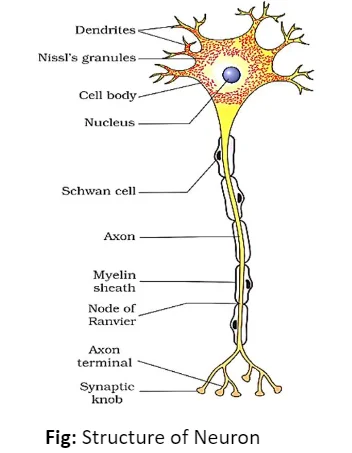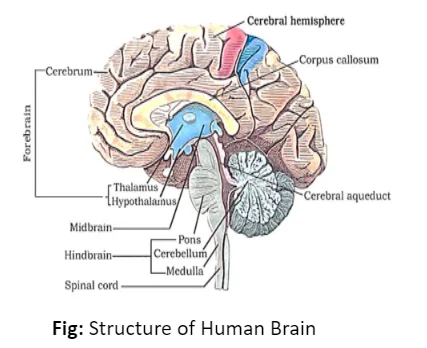The nervous system helps our body by passing signals from our senses to where they need to go for a response. There are two main types: diffuse, found in lower invertebrates, and centralised, found in higher invertebrates and vertebrates like us. In our bodies, impulses travel to and from the central nervous system (CNS) through the peripheral nervous system (PNS). Our brain is like the command centre, with different parts handling different tasks.
Understanding the Nervous System
- Definition of the Nervous System: The nervous system is an organised group of cells specialised for the conduction of electrochemical stimuli from sensory receptors through a network to the site at which a response occurs.

- Types of Nervous Systems: Nervous systems are of two general types, diffuse and centralised.
- Diffuse Nervous System: In the diffuse type of system (found in lower invertebrates), the brain is absent, and neurons are distributed throughout the organism in a netlike pattern.
- Centralized Nervous System: Higher invertebrates and vertebrates have centralized nervous systems.
- In these systems, a portion of the nervous system plays a dominant role in coordinating information and directing responses.
- Vertebrates, in particular, have a well-developed brain and spinal cord, collectively known as the central nervous system (CNS).
- Centralization reaches its peak in vertebrates, where the brain and spinal cord manage most functions of the nervous system.
- Impulses are carried to and from the CNS by nerve fibres that make up the peripheral nervous system (PNS).
- It is the body’s command centre.
Neurons
- Structure of a Neuron: A neuron is a microscopic structure composed of three major parts, namely, cell body, dendrites and axon.
- Cell Body: The cell body contains cytoplasm with typical cell organelles and certain granular bodies called Nissl’s granules.
- Dendrites: are projections of a neuron (nerve cell) that receive signals (information) from other neurons.
- Transmission of Information: The transfer of information from one neuron to another is achieved through chemical signals and electric impulses (electrochemical signals).
- Excitability of Neurons: Neurons are excitable cells because their membranes are in a polarised state. Different types of ion channels are present on the neural membrane. These ion channels are selectively permeable to different ions.
- Synapses and Transmission: A nerve impulse is transmitted from one neuron to another through junctions called synapses. A synapse is formed by the membranes of a pre-synaptic neuron and a postsynaptic neuron, which may or may not be separated by a gap called synaptic cleft.
Human Brain
-
- The brain is the central information processing organ of our body and acts as the ‘command and control centre’.

- It can be divided into 3 major parts: Fore-brain, Mid-brain and Hid-brain.
- Fore-brain:
- The forebrain includes cerebrum, thalamus and hypothalamus.
- Cerebrum: The cerebrum is the largest part of the human brain. It’s split into two halves, the left and right cerebral hemispheres, by a deep cleft running lengthwise.
-
-
-
- Corpus Callosum: Nerve fibre tract connecting the hemispheres.
- Cerebral Cortex: Outer layer with prominent folds, known as grey matter due to neuron cell bodies.
- Functions: plays a central role in the processing of information related to complex cognitive activities, sensory and associative functions, and voluntary motor activities.
- Thalamus: Located beneath the cerebrum.
- Major coordinating center for sensory and motor signals.
-
-
-
- Positioned at the base of the thalamus.
- Controls body temperature, eating, and drinking urges.
- Contains neurosecretory cells that produce hypothalamic hormones.
-
- Composed of inner cerebral structures like the amygdala and hippocampus.
- Involved in regulating sexual behavior, emotional reactions (e.g., excitement, pleasure, rage, fear), and motivation.
- Works closely with the hypothalamus.
- White Matter: Inner part of the cerebral hemisphere, made up of myelinated nerve fibres, giving it an opaque white appearance.
- Mid-brain:
- Function: It serves important functions in motor movement, particularly movements of the eye, and in auditory and visual processing. It is smaller compared to other regions.
- Located between the thalamus/hypothalamus (forebrain) and pons (hindbrain).
- Contains a canal called the cerebral aqueduct.
- The Dorsal portion has four round swellings called corpora quadrigemina.
- Hind-brain:
- It is the region composed of the medulla oblongata, the pons, and the cerebellum and coordinates functions that are fundamental to survival (including respiratory rhythm, motor activity, sleep, and wakefulness). Components of Hindbrain given as below,
- Pons: Contains fibre tracts connecting different brain regions.
- Cerebellum: Has a convoluted surface for more neurons.
- Medulla (Medulla Oblongata): Connects the brain to the spinal cord and controls respiration, cardiovascular reflexes, and gastric secretions.
- Brain Stem: Composed of the midbrain, pons, and medulla oblongata.
- Connects the brain to the spinal cord.
Conclusion
- The nervous system is like a communication network in our body, helping us respond to the world around us.
- Neurons, the cells in our nervous system, send messages through chemical signals and electric impulses.
- The brain, divided into three parts (forebrain, midbrain, and hindbrain), helps us think, feel, move, and stay alive by coordinating different functions. The nervous system is vital for our survival and everyday activities.
![]() June 5, 2024
June 5, 2024
![]() 1325
1325
![]() 0
0

